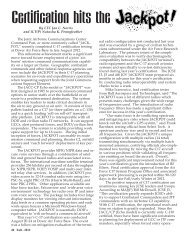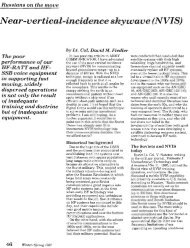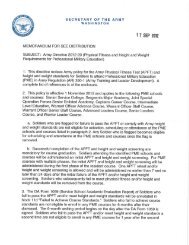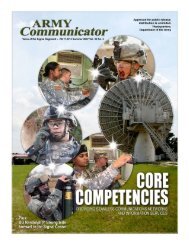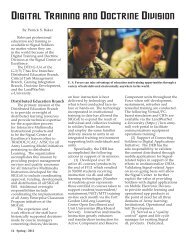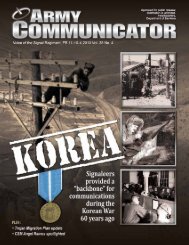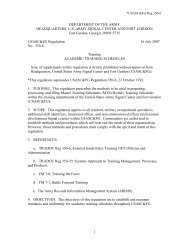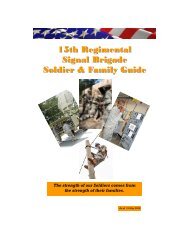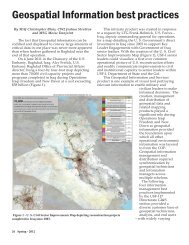AC Summer 08 WIN-T Online - United States Army Signal Center of ...
AC Summer 08 WIN-T Online - United States Army Signal Center of ...
AC Summer 08 WIN-T Online - United States Army Signal Center of ...
Create successful ePaper yourself
Turn your PDF publications into a flip-book with our unique Google optimized e-Paper software.
support the Intel community<br />
by providing connectivity for tactical<br />
SCIFs. In addition, BCBL(G) is<br />
investigating and assessing pertinent<br />
<strong>WIN</strong>-T-related technologies including<br />
802.11, 802.16, Combat Net<br />
Radio-over-IP, tactical cellular<br />
networks and Secure Mobile Environment<br />
Portable Electronic Devices.<br />
The BCBL(G) also supports the<br />
Special Operations and Joint communities<br />
in addressing current<br />
capability gaps. In FY07 the BCBL(G)<br />
assessed a U.S. <strong>Army</strong>, Special<br />
Operations Command iDirect-based<br />
network and optimized the network<br />
performance <strong>of</strong> their remote Super<br />
High Frequency “fly-away” packages<br />
to meet their command and<br />
control requirements. Early in FY<strong>08</strong><br />
the BCBL(G) evaluated a commercially<br />
available ruggedized<br />
deployable cellular communications<br />
system that could operate with<br />
National Security Agency approved<br />
Type 1 secured cellular devices to<br />
meet a current U.S. Marine Corps C2<br />
capability gap in theater.<br />
Mr. White retired from active<br />
duty with more than 21 years <strong>of</strong> service.<br />
He has been a Department <strong>of</strong> the <strong>Army</strong><br />
civilian at the Fort Gordon Battle Lab<br />
since 1995 and is currently the NSC-T<br />
technical director.<br />
<strong>AC</strong>RONYM QUICKSCAN<br />
AMEDD – <strong>Army</strong> Medical Department<br />
AONS – Architecture, Operations,<br />
Networks, and Space<br />
ATM – Asynchronous Transfer<br />
Mode<br />
BCBL(G) – Battle Command Battle<br />
Lab (Gordon)<br />
BSN – Brigade Subscriber Node<br />
CDID – Capability Development<br />
Integration Directorate<br />
CERDEC – CECOM Research<br />
and Development Command<br />
CSH – Combat Support Hospital<br />
CTC – Combat Training <strong>Center</strong><br />
DSN – Defense Switched Network<br />
DTP – Detailed Technical Procedure<br />
FCS – Future Combat System<br />
FY – fiscal year<br />
56 <strong>Summer</strong> 20<strong>08</strong><br />
Theater Tactical Sig Bde<br />
concept now a reality<br />
By 2LT Jon Reiss, CPT Joseph<br />
Kachmar, and MAJ Rob Fago<br />
The 11th Theater Tactical<br />
<strong>Signal</strong> Brigade from Fort Huachuca,<br />
Ariz., deployed in October 2007 as<br />
the first non-organic signal brigade<br />
to support a deployed corps headquarters.<br />
The 11th initially supported<br />
the III Corps from Fort Hood,<br />
Texas, who was executing the<br />
mission <strong>of</strong> the Multi-National Corps-<br />
Iraq. In February 20<strong>08</strong>, XVIII<br />
Airborne Corps from Fort Bragg,<br />
N.C., replaced III Corps. Dubbed<br />
“Task Force Thunderbird”, the 11th<br />
<strong>Signal</strong> Brigade headquarters combined<br />
with the 44th Expeditionary<br />
<strong>Signal</strong> Battalion from Manheim,<br />
Germany, and the 63rd ESB from<br />
Fort Gordon, Ga., to provide critical<br />
communications support for the<br />
MNC-I commander and corps<br />
operations in Iraq.<br />
The TTSB and its subordinate<br />
ESBs are part <strong>of</strong> the <strong>Army</strong>’s transformational<br />
signal support construct to<br />
the warfighters. The TTSB mission is<br />
to provide battle command, funding,<br />
manning, logistics and administrative<br />
support, as well as training and<br />
readiness oversight for the ESBs. The<br />
brigade headquarters also provides<br />
augmentation to the corps G6 for<br />
NetOps and engineering when the<br />
corps is functioning as a Joint Task<br />
Force.<br />
The Corps G6 and the TTSB<br />
commander have different but<br />
complementing missions; both are<br />
important and neither can fail. They<br />
draw from the corps’ mission and<br />
commanders’ intent. “If everyone is<br />
heading in the same direction, it<br />
does not matter who drives the<br />
train” comments COL John<br />
Hildebrand, the TF Thunderbird<br />
commander.<br />
The TTSB commander focuses<br />
on training, personnel, and equipment<br />
readiness <strong>of</strong> the ESBs’ modular<br />
Joint Network Transport Capability<br />
teams. The TTSB staff is masters <strong>of</strong><br />
employing and maneuvering ESBs<br />
across the battle space, but are<br />
primary subject matter experts on<br />
the technical aspects <strong>of</strong> JNTC and<br />
various other ESB assemblages.<br />
Because the ESBs are fielded with<br />
the same JNTC equipment as the<br />
brigade combat teams, the staff is<br />
<strong>of</strong>ten called upon to assist fellow<br />
communicators within the divisional<br />
battle space. The TTSB commander<br />
has a full multi-disciplined staff, so<br />
he is able to conduct mission planning,<br />
synchronize movements <strong>of</strong><br />
forces, conduct reliefs in place,<br />
schedule reset <strong>of</strong> equipment, and<br />
move equipment around the battle<br />
space. Using additional non-JNTC<br />
equipment specifically fielded to the<br />
ESB, like the AN/TSC-156B (Phoenix),<br />
the staff is able to enhance the<br />
services greatly provided to battlefield<br />
commanders and can extend<br />
the network to an increased number<br />
<strong>of</strong> customers. These are just a few <strong>of</strong><br />
the missions that the corps G6 is not<br />
manned or equipped to complete.<br />
CNOSC -- XVIII Airborne Corps G6<br />
and TF Thunderbird S3 Engineering<br />
Section<br />
The corps G6 and his staff’s<br />
primary focus remains on ensuring<br />
the corps commander can communicate<br />
with his staff, division commanders,<br />
and BCT commanders. As<br />
a staff section, they assist in all<br />
aspects <strong>of</strong> corps and division staff<br />
planning and the orders process<br />
with an emphasis on identifying<br />
emerging communications require



